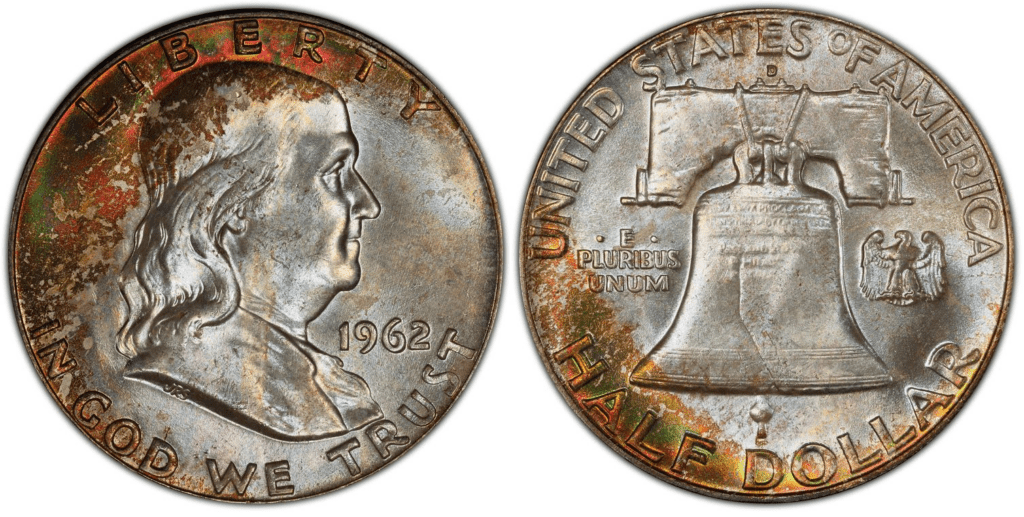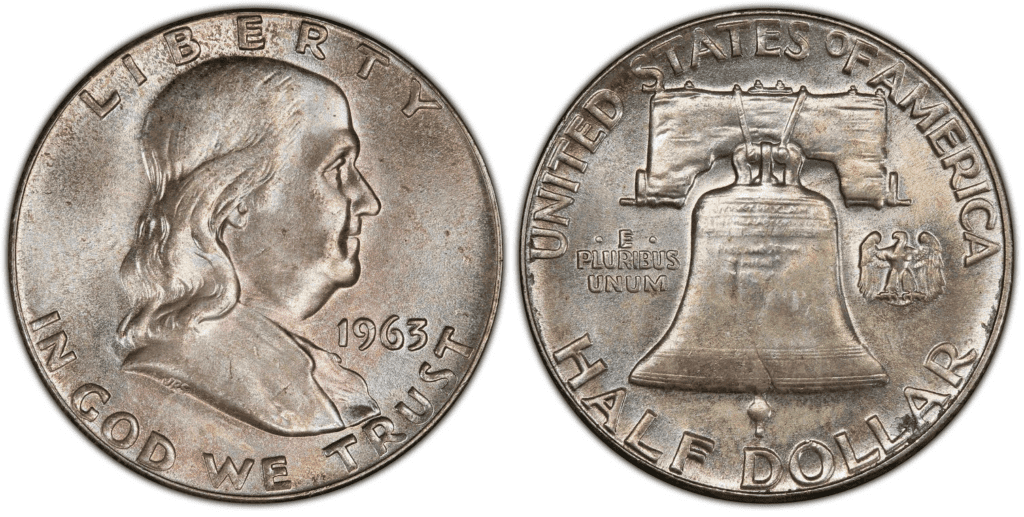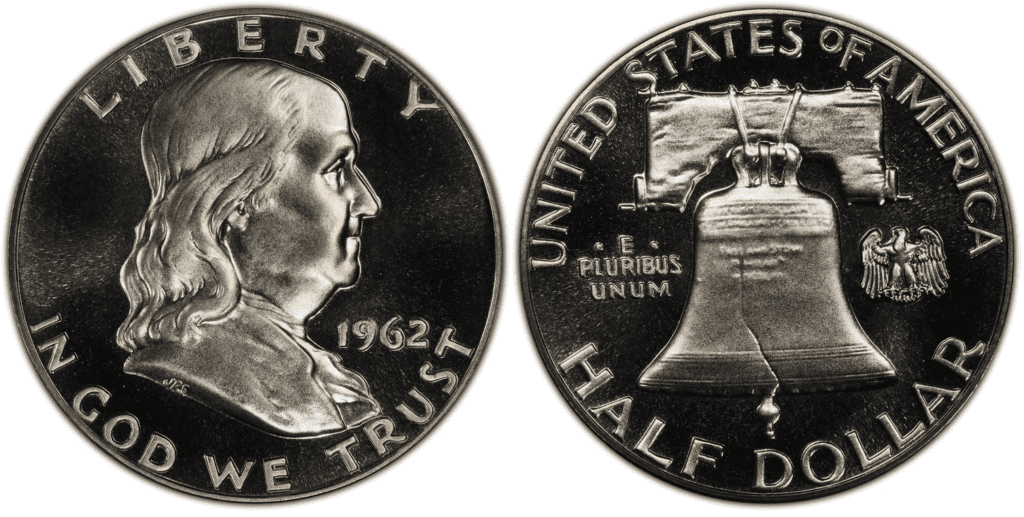What Is the 1962 Franklin Half Dollar Made Of?
The 1962 Franklin half-dollar is made of 90 percent silver and 10 percent copper. It has a composition of 0.36169 troy oz silver. The 90% silver and 10% copper composition have been the same composition of all Franklin half-dollars made from 1948 until 1963.
Here are the specifications of the 1962 Franklin half dollar:
- Value – 50 cents
- Mass – 12.50 grams
- Diameter – 30.61 millimeters
- Thickness – 1.8 millimeters
- Edge – reeded
The first Franklin 50-cent coin was issued in 1948, replacing the Walking Liberty half dollar, which was the design of the 50-cent coin from 1916 to 1947.
Of course, the 50-cent coin has already been in circulation since 1794 with its first Flowing Hair design. Since then, it has undergone different design changes that include Draped Bust, Capped Bust, Seated Liberty, and Barber.
As its name suggests, the 1962 half-dollar features the bust of Benjamin Franklin facing right. He is one of the Founding Fathers of the United States of America.
Mint director Nellie Tayloe Ross spearheaded the conversion of the 50-cent design from the Walking Liberty to Franklin. John Sinnock, the chief engraver at that time, was tasked to prepare the design. Regrettably, Sinnock only managed to design the obverse and didn’t finish the reverse. That was where Gilbert Roberts was asked to complete the design.
The US Mint presented Sinnock’s design to the Commission of Fine Arts. They didn’t like the design. Nevertheless, the US Mint decided to proceed with the design.

Now, for the design, you will find the right headshot of Franklin. Inscriptions include the following:
- LIBERTY
- IN GOD WE TRUST
- 1962
On the reverse side, you have the Liberty Bell. It also has a small eagle with its wings outspread. The inscriptions include the following:
- UNITED STATES OF AMERICA
- E PLURIBUS UNUM
- HALF DOLLAR
A lot of controversy surrounds the reverse design. The Commission of Fine Arts actually disapproved of it. They believe that the crack on the Liberty Bell would be the subject of puns and jokes. The institution also believed that the eagle was too small. Nevertheless, the US Mint went on to still use the design.
Aside from that, historians noted that Franklin didn’t like eagles. He thought of eagles as scavengers, as you might hear from numismatic lore. Plus, he preferred the wild turkey as a better bird than the eagle.
The Franklin half-dollar would eventually be replaced by the Kennedy half dollar, in honor of the service given by the assassinated President, John F. Kennedy.
1962 Franklin Half Dollar Varieties
The 1962 Franklin half dollar has at least three varieties, which include a proof version. The US Mint that produced the 1962 half-dollar coin were Denver and Philadelphia. If you look at the coin varieties, there are no big differences besides their mint mark. However, proof coins are known to be more detailed and shinier.
1962 half-dollar error coins also exist, giving rise to new varieties.
Here are the 1962 Franklin half-dollar varieties that you should know:
1962 D Franklin Half Dollar
Year of minting: 1962
Mint Mark: D
Place of minting: Denver
Quantity produced: 35,473,281
Face Value: $0.50 (one cent)
Price: $0.50 to $11.00 (or more)
Mass: 12.50 grams
Edge: Reeded
Designer: John Sinnock (with the help of Gilroy Roberts)
Composition: 90% silver and 10% copper
Diameter: 30.00 mm
Thickness: 1.8 mm

The 1962 D half dollar was produced in the Denver Mint. At the end of 1962, there were more than 35 million of these coins produced. This made the 1962 D half-dollar variety have the highest mintage compared to the number of coins issued by the Philadelphia Mint.
You can buy the 1962 D 50-cent coin starting at $0.50 to $11.00. However, there are a lot of 1962 half-dollar coins that were known to have been sold for more.
Yes, there are plenty of 1962 D 50-cent coins. However, coins like these with MS-65 grading become scarce and, therefore, costlier. MS-66 graded coins are far rarer, with less than 24 examples known. According to records, no 1962 D 50-cent coin has a higher grade of MS66 FBL.
1962 P Franklin Half Dollar
Year of minting: 1962
Mint Mark: Absent
Place of minting: Philadelphia
Quantity produced: 9,714,000
Face Value: $0.50 (one cent)
Price: $0.50 to $17.00 (or more)
Mass: 12.50 grams
Edge: Reeded
Designer: John Sinnock (with the help of Gilroy Roberts)
Composition: 90% silver and 10% copper
Diameter: 30.00 mm
Thickness: 1.8 mm

The Philadelphia Mint produced more than 9.7 million of 1962 half-dollar coins.
Some of the rarest 1962 no-mint mark half-dollar coins are the ones with Full Bell Lines on the reverse. Today, there are no 1962 P 50-cent coins with a grade higher than MS-66.
On average, you can buy or sell 1962-P coins for $0.50 to $17.00.
1962 P Franklin Half Dollar (Proof)
Year of minting: 1962
Mint Mark: Absent
Place of minting: Philadelphia
Quantity produced: 3,218,019
Face Value: $0.50 (one cent)
Price: $0.50 to $22.00 (or more)
Mass: 12.50 grams
Edge: Reeded
Designer: John Sinnock (with the help of Gilroy Roberts)
Composition: 90% silver and 10% copper
Diameter: 30.00 mm
Thickness: 1.8 mm

The Philadelphia Mint also produced proof coins in 1962. Although today, proof coins are produced in the San Francisco Mint.
Proof coins are produced differently. The die is struck with extra force to really bring out a more detailed look. After that, coins are wiped and cleaned thoroughly to bring out a higher level of shine and luster.
Since the 1962 half-dollar proof coins were more time-consuming to produce, there were only about 3.2 million of these coins made. Nevertheless, it’s not a problem since proof coins are made for collectors and not for circulation.
The 1962 50-cent proof coins can be sold or bought from $0.50 to $22.
List of 1962 Franklin Half Dollar Errors
In 1962, there were a total of more than 48.2 million Franklin half-dollar coins produced by the US Mint. As you can imagine, the more coins you produce, the higher the chance you’ll get error coins.
Aside from that, the US Mint didn’t have the same first-class technology back then. So, errors will inevitably happen.
Although error coins are undesirable and the US Mint definitely wants coins that are properly produced, a lot of coin collectors love error coins. For one, error coins are unique and sometimes rare. This adds to its value, making it more expensive.
There are different error coins for the 1962 Franklin half-dollar coins. Here are some of them:
- Die errors – due to wear and tear, dies can crack. When a cracked die hits the planchet, the crack leaves a mark on the coin.
- Planchet errors – the planchet or blank coin needs to be cut in a perfect circle. Sometimes, coins get clipped or are molded in the wrong shape and thickness.
- Strike error – the die needs to strike the coin to impress the design. The problem happens when the strike hits the planchet at the wrong angle, leading to off-center or misaligned strikes.
How Much Is the 1962 Franklin Half Dollar Worth Today?
The 1962 Franklin half-dollar has a face value of $0.50. Thankfully, it has a higher melt value since it is made of silver. Melt value can be as high as $7.7. Silver often changes in value. So, the melt value can be higher or lower, depending on the market price.
While a melt value of $7.7 seems to be high, you would be surprised that some 1962 half-dollar coins can be worth thousands of dollars.
Check out this 1962 Franklin Half Dollar values chart to learn more about its prices:
| Coin | Condition | Grade | Mintage | Value |
| 1962 D Franklin half dollar | Circulated/mint | Not graded | 35,473,281 | $0.50 to $11.00 |
| 1962 D Franklin half dollar | Uncirculated/mint | MS-65 | 35,473,281 | $39 to $112 |
| 1962 D Franklin half dollar | Uncirculated/mint | MS-66 | 35,473,281 | $336 to $558 |
| 1962 D Franklin half dollar | Uncirculated/mint | MS-67 | 35,473,281 | $4,313 to $5,750 |
| 1962 P Franklin half dollar | Circulated/mint | Not graded | 9,714,000 | $0.50 to $17.00
|
| 1962 P Franklin half dollar | Uncirculated/mint | MS-64 | 9,714,000 | $15 to $82 |
| 1962 P Franklin half dollar | Uncirculated/mint | MS-65 | 9,714,000 | $32 to $100 |
| 1962 P Franklin half dollar | Uncirculated/mint | MS-66 | 9,714,000 | $360 to $760 |
| 1962 P Franklin half dollar (Proof) | Uncirculated/proof | Not graded | 3,218,019 | $0.50 to $22.00
|
| 1962 P Franklin half dollar (Proof) | Uncirculated/proof | PR-67 | 3,218,019 | $28 to $128 |
| 1962 P Franklin half dollar (Proof) | Uncirculated/proof | PR-68 | 3,218,019 | $45 to $130 |
| 1962 P Franklin half dollar (Proof) | Uncirculated/proof | PR-69 | 3,218,019 | $180 to $336 |
As you can see, the price of the 1962 half dollar can be worth hundreds and thousands of dollars.
How Does The Grading System Work?
The Sheldon Scale is used by numismatists to provide a numerical value to coins. The Sheldon Scale goes from poor (P-1) to perfect mint state (P-1) (MS-70). Coins were originally evaluated using words to reflect their condition (Good, Fair, Excellent, Etc.). Unfortunately, coin collectors and dealers had different ideas about what each of these terms represent.
Professional numismatists joined together in the 1970s and established CoinGrading standards. These numismatists now assign grades at key places on the seventy-point scale, using the most regularly utilized numeric points in conjunction with the original adjective grade. The following are the most common coin grades:
-
-
- (P-1) Poor – Indistinguishable and probably damaged; if used, must have a date and mintmark; otherwise, rather battered.
- (FR-2) Fair – Nearly smooth, but without the damage that a coin graded Poor often possesses. The coin must have enough detail to be identified.
- (G-4) Fair – Inscriptions have merged into the rims in some areas, and important elements have been mostly erased.
- (VG-8) Very Good- A little weathered, but all of the primary design elements are visible, albeit faintly. There is little if any, central detail left.
- (F-12) Good – The item is very worn, yet the wear is even, and the overall design details stand out clearly. Rims are almost completely isolated from the field.
- (VF-20) Very Fine – Moderately weathered, with some finer features still visible. The motto or all letters of LIBERTY are readable. Both sides of the coin have entire rims that are separated from the field.
- (EF-40) Extremely Fine – Gently used; all gadgets are visible, and the most important ones are bold. The finer details are bold and clear, however, light wear may be seen.
- (AU-50) Uncirculated – Slight evidence of wear on the coin’s design’s high points; may have contact marks; eye appeal should be adequate.
- (AU-58) Uncirculated Choice – Slight traces of wear, no severe contact marks, almost full mint shine, and great eye appeal.
- (MS-60) Mint State Basal – Strictly uncirculated; no indication of wear on the coin’s highest points, but an unsightly coin with reduced luster, visible contact marks, hairlines, and other flaws.
- (MS-63) Mint State Acceptable – Uncirculated, but with contact scratches and nicks, little reduced shine, but otherwise appealing appearance. The strike is weak to average.
- (MS-65) Mint State Choice – Uncirculated with great mint shine, very little contact blemishes, and exceptional eye appeal. The strike is unusually severe.
- (MS-68) Mint State Premium Quality – Uncirculated with superb luster, no obvious contact marks to the naked eye, and exceptional eye appeal. The strike is quick and appealing.
- (MS-69) Almost Perfect Mint State – Uncirculated with perfect brilliance, a sharp and appealing strike, and extremely good eye appeal. A near-perfect coin with minor imperfections in the planchet, strike, and contact markings (seen only under 8x magnification).
- (MS-70) Mint State Perfect – Under 8x magnification, there are no tiny imperfections discernible; the strike is crisp, and the coin is perfectly centered on a beautiful planchet. Rarely seen on a coin, this coin is bright and whole, with original luster and exceptional eye appeal.
-
Where To Buy Or Sell 1962 Franklin Half Dollar?
The most common place to buy and sell 1962 Franklin half dollars would be the Internet. With just a few clicks, you can search for 1962 50-cent coins. You can go to online buy-and-sell platforms such as eBay and Amazon. You can also do a Google search to find websites specializing in collecting coins.
Aside from the Internet, you can go to coin shops and antique stores. They could have 1962 Franklin coins for sale. Aside from that, you can try to contact local clubs of coin collectors. They may be able to give you more details about where to buy and sell 1962 half dollars.
FAQs
Is the 1962 Franklin Half 90% silver?
The 1962 Franklin half dollar is 90% silver. The rest is made of copper.
What are the key dates for Franklin half-dollars?
The key dates for the Franklin half dollars would be 1948, 1949, 1953, and 1955.
How many 1962 half dollars were produced?
There were 48,405,300 half dollars produced in 1962. To break it down, there were 35,473,281 from the Denver Mint and 12,932,019 from the Philadelphia Mint.
What 1962 Franklin half-dollar is worth $8,000?
Based on records, no 1962 Franklin half-dollar has been sold for $8,000. However, this price tag may be realistic if you found 1962 coins with a grade higher than MS 66 with Full Bell Lines.
